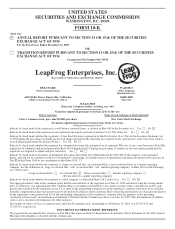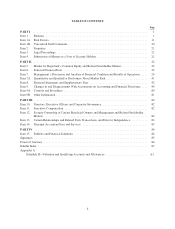LeapFrog 2009 Annual Report Download - page 17
Download and view the complete annual report
Please find page 17 of the 2009 LeapFrog annual report below. You can navigate through the pages in the report by either clicking on the pages listed below, or by using the keyword search tool below to find specific information within the annual report.
We are subject to the Consumer Product Safety Improvement Act of 1972, as amended in August 2008 by the
Consumer Product Safety Improvement Act, or CPSIA, the Federal Hazardous Substances Act, the Flammable
Fabrics Act, regulation by the CPSC, and other similar federal, state and international rules and regulatory
authorities. While we believe we are currently in compliance with the CPSIA standards for lead and other
substances, additional requirements under CPSIA will become effective through 2011. Any unanticipated failure
to comply with those upcoming requirements could lead to products returns or inventory write-offs. For more
information about the adverse effects that could result from possible errors or defects in our products, see Part I,
Item 1A.—Risk Factors—“Any errors or defects contained in our products, or our failure to comply with
applicable safety standards, could result in recalls, delayed shipments and rejection of our products and damage
to our reputation, and could expose us to regulatory or other legal action.”
LeapFrog’s quality control system processes include product testing and verification for safety and reliability,
starting in the design phase of a product’s life cycle and continuing through production and field support. Our
testing for safety is generally more frequent than standards require, and focused testing for special areas of
interest, such as chemical compliance controls is undertaken even more frequently. We set standards for supplier
performance and we make routine assessments of and take steps to verify compliance with our quality standards.
We communicate those expectations to our suppliers regularly and work with them to sustain the process of
consistently producing safe products. We work with a relatively small group of contract manufacturers, some of
which are specialized for the consumer electronics manufacturing sector.
Research and Development
LeapFrog designs its hardware platforms and related software-based content using in-house research and
development resources and outside consultants as necessary. Generally, once the design phase of the product is
complete, the remaining development and manufacturing of the products are outsourced to third parties. Our total
research and development costs were $35.0 million, $48.5 million, and $59.4 million in 2009, 2008 and 2007,
respectively.
•Hardware and Software Development: We believe that investment in research and development is a
critical factor in strengthening our portfolio of products. We have assembled a team of specialists with
backgrounds in a wide variety of fields including education, child development, hardware engineering,
software development, video games and toys. We have internally developed each of our current
platforms and stand-alone products, although we use licensed technology if warranted. For example, we
use a version of Macromedia’s Flash player in our Leapster handheld platform. We also use optical
pattern recognition hardware and software from Anoto AB in our Tag reading system.
•Content Development: Our content production department has developed large portions of the content
for our interactive books, educational games, and stand-alone products, applying our proprietary
pedagogical approach, which is based on established educational standards. Much of our content uses
licensed characters, such as the Disney Princesses, Thomas the Tank Engine, Sonic the Hedgehog,
SpongeBob SquarePants and characters from the movies “Indiana Jones,” “Hannah Montana,” “Star
Wars: the Clone Wars” and “Wall-e.” We develop most of our concept designs in-house. Most members
of our in-house content development and production team have prior experience in the education,
entertainment and educational software or video game industries.
Some elements of our product development cycle and most of our game production are performed by third-party
contractors to improve efficiency and control costs.
Advertising and Marketing
Our advertising and marketing strategy is designed to position LeapFrog as a leader in providing engaging,
effective, technology-based learning solutions primarily for children. Our communication supports a strong brand
that parents seek out to teach children in a fun and engaging way, with the goal of building their love of learning.
7
























